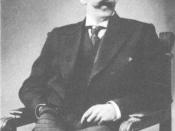Bertolt Brecht and Constantin Stanislavski are regarded as two of the most influential practitioners of the twentieth century, both with strong opinions and ideas about the function of the theatre and the actors within it. Both theories are considered useful and are used throughout the world as a means to achieve a good piece of theatre. The fact that both are so well respected is probably the only obvious similarity as their work is almost of complete opposites.
Stanislavski was born in 1863 to a wealthy family who loved amateur theatricals. In 1898 he met Vladimir Nemirovich-Danchenko and they founded the Moscow Art Theatre. Stanislavski's work is centred on the notion that acting should be a total lifelike expression of what is being imitated.
With regards to the role of the theatre, and of it audience, Stanislavski viewed theatre as a means of artistically expressing things, and that the audience's role was to 'look in' on the action on the stage.
He favoured the idea of the 'fourth wall' which separated the audience and the actors, to re-create total realism on the stage. He wanted the audience to feel the pain or joy of the actor, and that watching a performance would have brought out a feeling of empathy.
Stanislavski believed in ensemble acting and wanted to take theatre away from the idea of having a star, to create as near to naturalism as possible.
Bertolt Brecht was born in 1898, thirty-five years after Stanislavski, in Augsburg to a paper-mill managing director. His life was spent moving from country to country, fleeing from Nazi forces and other political pressures. In 1949 Brecht and Helene Weigel founded the Berliner Ensemble, which in 1990 (thirty-four years after Brechts death) was transformed into a public corporation with an enormous city subsidy and a...


